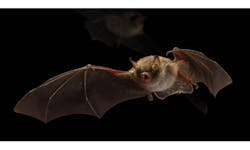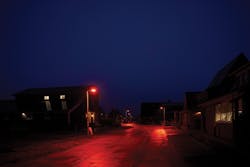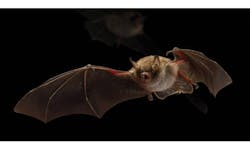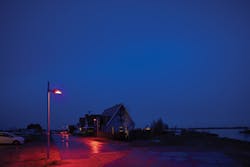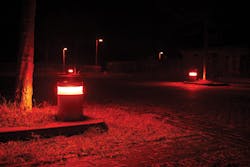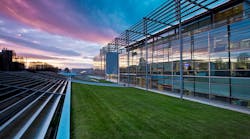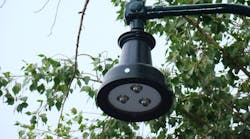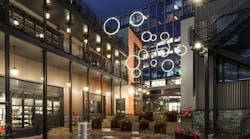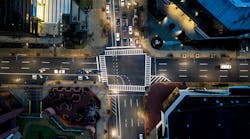Specially-tuned residential street lights from Signify will help certain species overcome their aversion to light. But will humans be able to see in this spectrum? MARK HALPER reports.
Some people like to collect record albums. Some people pile up audio gems of other sorts. Take Kamiel Spoelstra, for instance. He has 1.5 million recordings of bat sounds.
Yes, bats. As in the planet’s only flying mammals.
No, he didn’t download them, and no, they’re not ringtones. Rather, Spoelstra and his team of scientists at the Netherlands Institute of Ecology (NIOO-KNAW) made them, in order to analyze the effect of outdoor artificial light on the nocturnal creatures. Experts have long known that many types of bats shy away from light at night. Spoelstra and his crew wanted to delve deeper into thatknowledge.
So, starting in 2011 they mounted microphones and memory cards on trees near specially-tuned LED lightposts they installed at eight different sites in the Netherlands. Spoelstra’s ultrasonic equipment would pick up the high-frequency bat calls that are inaudible to human ears but that sound out at deafening decibels that put Iron Maiden to shame.
In each location, Spoelstra erected four rows of five poles, one row emitting red, one white, one green, and one emitting no light at all.
By listening to bat activity around each row, they could get a good sense of whether some light frequencies are more intimidating to bats than others. With around 20 or so of the world’s roughly 1200 species of bats endangered, environmentalists want to understand such things, so that towns and rural areas might adjust lighting in ways that foster bat activity while also still providing illumination to humans.
Five years and many terabytes of data later, Spoelstra and his team — which also included Holland’s University of Wageningen — had enough evidence to conclude that red light is the cure that will help bats overcome their aversion to light (Fig. 1).
FIG. 1. For bats, red means “go” on the streets of Zuidhoek-Nieuwkoop.
“The results were really clear,” said Spoelstra, a behavioral ecologist at Wageningen-based NIOO, which is part of the Dutch Royal Academy of Sciences, a government advisory group. “The light-shy bats, which are the more rare species, are active in darkness, they forage in darkness, but their activity is heavily suppressed by white and green light. As soon as they see it, they shy away. But not so for the red.” In fact, added Spoelstra, “they are equally active in red light as indarkness.”
It was around the red lights where the Spoelstra tapes, if you will, picked up the bat cries.
Fast forward to today, where in the new, environmentally progressive Dutch residential development of Zuidhoek-Nieuwkoop, Signify — formerly Philips Lighting — has leveraged Spoelstra’s findings and switched on 53 new streetlight luminaires and 69 new pathway and parking area post lights, all emitting red light. There are more lights to come, too.
The idea is to protect the bat population in the Nieuwkoop area, which is part of the European Union’s Natura 2000 network of nature protection areas for rare and threatened species. The 89 new Zuidhoek homes within Nieuwkoop represent an initiative to adhere to sustainable housing and development standards. Protecting the local bat population is a key portion of the plan. Therefore, bat-friendly lighting is crucial.
In fact, it was Signify senior scientist Maurice Donners who initially came up with the red recipe, having prescribed it to Spoelstra to test. Spoelstra’s results left no doubt about which color Signify wouldimplement.
“The bats are less sensitive to the red/orange part of the spectrum,” said Donners. “Those colors appear less bright to them. The same goes for many other mammals — with voles, rats, and rabbits, for instance, it’s comparable. If you show two lights of equal brightness, one in green and one in red, the red light will appear darker than the green light, or than white light to them.” (While Spoelstra also studied the effect of light and light posts on other small mammals, the Zuidhoek-Nieuwkoop installation is tuned specifically for bat life.)
Dangerous detours, fast food
The darker appearance is vital to many bats, because some bats will literally go to great lengths to avoid illumination on their way to their feeding areas (Fig. 2). Since bats by nature hunt up to a few kilometers away from their roosting spots — “they commute,” as Spoelstra put it — any detour poses hazards. Chief among them is the extra exertion, which is a double whammy because not only does it tire them out, but they then need to find and eat more food, typically insects, to recoup their burned-up calories.
FIG. 2. Bats such as this Myotis nattereri won’t have to take a circuitous route to their feeding ground because the red light won’t bother them the way other frequencies do. Myotis nattereri is named after early 19th-century Austrian naturalist Johann Natterer. (Photo credit: Kamiel Spoelstra.)
“They’ll need to fly a greater distance to get to their foraging grounds, which will take energy,” saidSpoelstra.
Some species can also become disoriented from the light, as bat campaigners have noted (see a related article on the Lux website at http://bit.ly/2tWRvux).
What’s more, deviating from their normal route also potentially exposes bats to predators, Spoelstra added. Odd as that might sound — there are few bat predators, occasionally an owl or a falcon gets lucky — it means that bats can’t afford to be careless about their routes, which in normal light/dark circumstances they find via by bouncing sound signals off of objects such as trees and listening for the echo, a biological wayfinding technique known as echolocation. (Myth buster: Bats are not blind. They have good eyesight, but at nighttime, their echolocation is farsuperior).
“It’s not very common that owls take bats, but on the other hand, bats have to be very careful,” observed Spoelstra. “Their reproduction rate is very low — they get just one young per year — so they do have to be very careful.”
In other words, they have to survive long enough to procreate and sustain.
The red lights are intended to help the bats in Nieuwkoop do just that, but they don’t help all of the area’s bats. As Signify’s Donners explained, the locals are basically divided into two types: fast and agile bats that don’t care about artificial light and cavalierly fly straight to their foraging ground even in the face of bright luminaires; and slower bats that do indeed shy away from the bright lights.
It is the slower ones — which are also rarer and thus potentially more threatened — that are expected to benefit from the red lights. To talk the talk, in Holland, the rarer, slower, and more light-shy bats tend to be from the Myotis and Plecotus genuses (Myotis are the mouse-eared variety; Plecotus are long-eared), while the common and cavalier bats tend to be Pipistrellus (from the Italian word for bat, pipistrello).
The light’s benefits are twofold. Not only will the light-shy bats avoid detours, but they should also end up with more insects available to them. That’s because normal white street lights attract swarming insects and thus serve as a ready-made easy meal for the bold, fast bats.
In normal white lighting conditions, “it’s like McDonalds to them,” said Signify’s Donners. But with the red lights, “there’s no moreMcDonalds.”
As Spoelstra explained, that is overall a good thing across the different bat species.
“A very nice thing about this is if you use red lights, the number of insects accumulating around the lamps is much lower,” he said. “As a result, the non-light shy bats do not forage as much around the red light. And that’s important, because if you place light somewhere you don’t want to help the very common bats, you want to help the bats that are not so abundant, that are a more rare species. So by placing red light, you don’t facilitate the common bats, and you don’t bother the more rare species.”
In the big picture, it all works out for the bats, as long as the insects don’t hear the echolocation signals (some can) and scatter away — a sort of bat and insect version of the cat and mouse game. But we digress.
What about us?
That all sounds great for bats. But what about humans? Can people really see well enough in the red light? After all, although Signify has been a leader in ecologically-sensitive lighting — it deployed blue-green LED lighting on Holland’s North Sea island of Ameland last year to help keep migratory birds from wandering off course as they can do in white light — the fundamental purpose of artificial lighting is to assist humans.
“We don’t make lights for bats; we make light for people,” Donners noted. “We assume someone wants to install lights in the first place because they want to provide a certain level of safety and illumination. So the second test was, ‘What is the minimum quality of light that we need to give this?’”
The answer: Signify determined that the most important feature was to ensure that the human eye could differentiate colors at night (Fig. 3).
FIG. 3. The red lights provide enough illumination for humans to be able to discern colors, such as on the cars in the lower left of this photo.
“One of the very important aspects is the ability to recognize colors,” Donners said. “For several reasons: If you’re in a car park and you can’t see any color, it would be very difficult to find your car. And seeing traffic signs. And the police, if they need a witness statement, it would be good to be able to say if someone was wearing a red coat, a green coat, or whatever. So there are many reasons why it’s useful to have some basic color vision. You don’t need really extreme color vision, but some basic recognition of colors is handy.”
It also helps that the residents of the exclusive Zuidhoek-Nieuwkoop development in principle have an environmentally-minded attitude that would inherently make them more tolerant of what some people might consider sub-optimal lightingconditions.
“Nieuwkoop is the first town in the world to use smart LED street lights that are designed to be friendly to bats,” said Guus Elkhuizen, a Nieuwkoop municipality council member.
Such absolute statements tend to be debatable. It’s certainly not the first time that a town has implemented special LED lighting to assist bats. Three years ago in another Signify project, the German city of Wuppertal, for instance, lit the inside of a recreational trail’s tunnel in a way that left a dark corridor near the top, in deference to bats, as Lux reported.
Still, there’s no denying that the Zuidhoek-Nieuwkoop housing area has an environmental ethos, and one that might induce people to compromise their own expectations of lighting for human purposes.
The Zuidhoek-Nieuwkoop project is also more extensive than the Wuppertal tunnel (Fig. 4). Nieuwkoop has connected the lights to Signify’s Interact City management software. Among other things, Interact allows operators to turn up the brightness on individual light points should it be necessary for, say, emergency services. The system can also dim to variable low light levels during overnight hours, for further energy savings in addition to the considerable savings provided by LED versus conventional high-pressure sodium (HPS) — estimated in this case to total around 70%.
FIG. 4. In addition to 53 street lights, Signify has to date also provided 69 pathway and parking area lights with the red recipe.
One thing the system is not programmed to do is to alter the light spectrum. The lights remain red year-round, in part because bats sometimes emerge sporadically from hibernation in winter months during weather blips.
Signify did not reveal where funding came from for the project or how much it cost. In the past, it has worked with oil and gas companies among other groups. Its history with environmental lighting dates back nearly 15 years, working with oil giant Shell to help prevent birds from flying into offshore rigs. Its Ameland project was partially funded by an oil and gas exploration company, as well as by Ameland and Signify itself.
“When developing our unique housing program, our goal was to make the project as sustainable as possible while preserving our local bat species with minimal impact to their habitat,” said Elkhuizen. “We’ve managed to do this and kept our carbon footprint and energy consumption to a minimum.”
Or, put another way, Zuidhoek-Nieuwkoop has the local bats seeing red. And in this case, that’s nothing to get angry about.
MARK HALPER is a contributing editor for LEDs Magazine, and an energy, technology, and business journalist ([email protected]).
